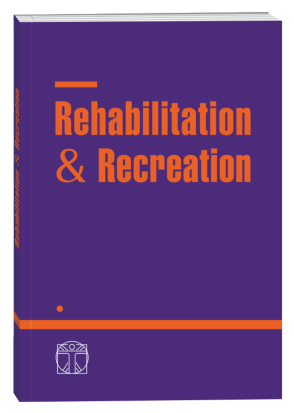EXPLORING THE USE OF THE CANADIAN OCCUPATIONAL PERFORMANCE MEASURE (COPM) IN UKRAINE: DETERMINING THE NEED
DOI:
https://doi.org/10.32782/2522-1795.2024.18.3.3Keywords:
occupational therapy, outcome measures, disability and health, disability evaluationAbstract
Purpose. The goal of the study was to explore the use of the Canadian Occupational Performance Measure (COPM) by occupational therapists in Ukraine and determining the perceived need for the COPM in Ukraine. Methods. A pilot survey was conducted with 213 Ukrainian occupational therapists using Qualtrics. Quantitative and qualitative data were collected and interpreted via descriptive statistics and thematic analysis assessing the therapists’ knowledge of the COPM, frequency of use, perceived benefits, and barriers to its use. Results. Results showed that while 58% of Ukrainian occupational therapists report some usage of the COPM in clinical practice, frequency of use is occasional rather than systemic. Perceived barriers to using the COPM included: lack of knowledge of the COPM and skills to administer it, lack of appreciation of the value of the COPM for clinical practice, time constraints, lack of integration of the COPM into documentation systems and reluctance to using the COPM for fear of being perceived unprofessional by the patients. Despite these challenges, the COPM was evaluated highly (8 out of 10) by the participants. The study also revealed a prevalent use of unauthorized Ukrainian translations of the COPM, with only 13% of therapists using the official translation version. Conclusions. The findings highlight the need for a rigorous, evidence-informed Ukrainian translation of the COPM and additional education of Ukrainian occupational therapists for its competent use. The study suggests that barriers to using the COPM may stem from a lack of understanding of the philosophy of occupation as the key concept of the profession and calls for further research into the use of occupation- and client-focused outcome measures in a medically dominated environment in Ukraine.
References
American Occupational Therapy Association (2021). Standards of practice for occupational therapy. American Journal of Occupational Therapy, 75(Suppl. 3), 7513410030. https://doi.org/10.5014/ajot.2021.75S3004.
Araújo, C.R.S., Cardoso, A.A., & Magalhães, L. d. C. (2019). Efficacy of the cognitive orientation to daily occupational performance with Brazilian children with developmental coordination disorder. Scandinavian Journal of Occupational Therapy, 26(1), 46–54. https://doi.org/10.1080/11038128.2017.1417476.
Beheshti, S.Z., Hosseini, S.S., Maroufizadeh, S., & Almasi-Hashiani, A. (2022). Occupational performance of children with autism spectrum disorder and quality of life of their mothers. BMC Research Notes, 15(1), 18. https://doi.org/10.1186/s13104-021-05890-4.
Berardi, A., Galeoto, G., Guarino, D., Marquez, M.A., De Santis, R., Valente, D., Caporale, G., & Tofani, M. (2019). Construct validity, test-retest reliability, and the ability to detect change of the Canadian Occupational Performance Measure in a spinal cord injury population. Spinal Cord Series and Cases, 5, 52–52. https://doi.org/10.1038/s41394-019-0196-6.
Bonn, M.M., Dickey, J.P., Moran, B., McGuire, S., & Graham, L. (2022). Completing an interdisciplinary outpatient intervention improves patient rehabilitation goals following a mild traumatic brain injury. Physiotherapy Theory and Practice, 39(2), 310–316. https://doi.org/10.1080/09593985.2021.2022046.
Burns, A.S., Marino, R.J., Kalsi-Ryan, S., Middleton, J.W., Tetreault, L.A., Dettori, J.R., Mihalovich, K.E., & Fehlings, M.G. (2017). Type and Timing of Rehabilitation Following Acute and Subacute Spinal Cord Injury: A Systematic Review. Global Spine Journal, 7(Suppl 3), 175–194. https://doi.org/10.1177/2192568217703084.
Caire, J.M., Maurel-Techene, S., Letellier, T., Heiske, M., Warren, S., Schabaille, A., & Destruhaut, F. (2022). Canadian Occupational Performance Measure: Benefits and Limitations Highlighted Using the Delphi Method and Principal Component Analysis. Occupational therapy international, 2022, 9963030. https://doi.org/10.1155/2022/9963030.
Cameron, D., Craig, T., Edwards, B., Missiuna, C., Schwellnus, H., & Polatajko, H.J. (2017). Cognitive Orientation to daily Occupational Performance (CO-OP): A New Approach for Children with Cerebral Palsy. Physical & occupational therapy in pediatrics, 37(2), 183–198. https://doi.org/10.1080/01942638.2016.1185500.
Canadian Association of Occupational Therapists. (2002). Enabling occupation: an occupational therapy perspective, (rev. ed.). Ottawa, ON: CAOT Publications ACE.
Carswell, A., McColl, M.A., Baptiste, S., Law, M., Polatajko, H., & Pollock, N. (2004). The Canadian Occupational Performance Measure: A research and clinical literature review. Canadian Journal of Occupational Therapy, 71(4), 210–222. https://doi.org/10.1177/000841740407100406.
Colquhoun, H.L., Letts, L.J., Law, M.C., MacDermid, J.C., & Edwards, M. (2010). Feasibility of the COPM for routine use. British Journal of Occupational Therapy, 73(5), 230–236. 10.4276/030802210X12658062793726.
Creswell, J.W., & Creswell, J.D. (2018). Research design: Qualitative, quantitative, and mixed methods approaches (5th ed.). SAGE Publications.
Cruchinho, P., López-Franco, M.D., Capelas, M.L., Almeida, S., Bennett, P.M., Miranda da Silva, M., Teixeira, G., Nunes, E., Lucas, P., Gaspar, F., & Handovers4SafeCare (2024). Translation, Cross-Cultural Adaptation, and Validation of Measurement Instruments: A Practical Guideline for Novice Researchers. Journal of multidisciplinary healthcare, 17, 2701–2728. https://doi.org/10.2147/JMDH.S419714.
Cup, E.H.C., Scholte op Reimer, W.J.M., Thijssen, M.C.E., & van Kuyk-Minis, M.A.H. (2003). Reliability and validity of the Canadian Occupational Performance Measure in stroke patients. Clinical Rehabilitation, 17(4), 402–409. https://doi.org/10.1191/0269215503cr635oa.
de Waal, M.W.M., Haaksma, M.L., Doornebosch, A.J., & et al. (2022). Systematic review of measurement properties of the Canadian Occupational Performance Measure in geriatric rehabilitation. European Geriatric Medicine, 13, 1281–1298. https://doi.org/10.1007/s41999-022-00676-7.
Diachuk, D.D., Moroz, G.Z., Gidzynska, I.M., Kravchenko, A.M. (2023). Zaprovadzhennia patsient-orientovanoho pidhodu ta udoskonalennia orhanizatsii medychnoi dopomohy na suchasnomu etapi (Ohliad literatury) [Introducing a patientoriented approach and improving the organization of medical care at the current stage. (Literature review)]. Klinichna ta profilaktychna medytsyna – Clinical and preventive medicine, 1 (23), 66–77. https://doi.org/10.31612/2616-4868.1(23).2023.10.
Duncan, E.A., & Murray, J. (2012). The barriers and facilitators to routine outcome measurement by allied health professionals in practice: A systematic review. BMC Health Services Research, 12(1), 96. https://doi.org/10.1186/1472-6963-12-96.
Enemark, Larsen, A., Rasmussen, B., & Christensen, J.R. (2018). Enhancing a Client-Centred Practice with the Canadian Occupational Performance Measure. Occupational Therapy International, 1–11. https://doi.org/10.1155/2018/5956301.
Enemark, Larsen, A., Jessen, Winge, C., & Christensen, J.R. (2021). Clinical utility of the Danish version of the Canadian Occupational Performance Measure. Scandinavian Journal of Occupational Therapy, 28(3), 239–250. https://doi.org/10.1080/11038128.2019.1634150.
Enlow, K., Fleischer, A., & Hardman, L. (2020). Acute-Care OT Practice: Application of the Canadian Occupational Performance Measure (COPM) in a Palliative-Care Program...2020 AOTA Annual Conference & Expo. American Journal of Occupational Therapy, 74(Sup1), 1–1. https://doi.org/10.5014/ajot.2020.74S1-PO7730.
Eyssen, I.C., Steultjens, M.P., Oud, T.A., Bolt, E.M., Maasdam, A., & Dekker, J. (2011). Responsiveness of the Canadian Occupational Performance Measure. Journal of Rehabilitation Research and Development, 48(5), 517–528. https://doi.org/10.1682/jrrd.2010.06.0110.
Forsythe, M.E., & Kviz, F.J. (2006). Survey research design. In G. Kielhofner (Ed.), Research in occupational therapy: Methods of inquiry for enhancing practice (pp. 91–109). F.A. Davis Company.
Law, M., Baptiste, S., Carswell, A., McColl, M.A., Polatajko, H., & Pollock, N. (2019). Canadian Occupational Performance Measure (5th ed.-revised). Altona, Canada: COPM Inc.
Toomey, M., Nicholson, D., & Carswell, A. (1995). The clinical utility of the Canadian Occupational Performance Measure. Canadian journal of occupational therapy. Revue canadienne d’ergotherapie, 62(5), 242–249. https://doi.org/10.1177/000841749506200503.
World Federation of Occupational Therapists. (2022). Human resource project 2022. World Federation of Occupational Therapists.
World Health Organization. (2001). International classification of functioning, disability and health (ICF). World Health Organization.
Wressle, E., Eeg-Olofsson, A.M., Marcusson, J., & Henriksson, C. (2002). Improved client participation in the rehabilitation process using a client-centred goal formulation structure. Journal of rehabilitation medicine, 34(1), 5–11. https://doi.org/10.1080/165019702317242640.
Downloads
Published
How to Cite
Issue
Section
License
Copyright (c) 2024 O. O. Mangusheva, O. B. Lazarieva, A. Enemark Larsen

This work is licensed under a Creative Commons Attribution-NonCommercial-NoDerivatives 4.0 International License.












